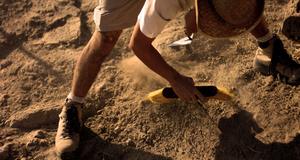From Earth Common Journal VOL. 3 NO. 1Hoarding Plastic Waste: Buried AlivePlastic: The Virtue of Decomposition and the Vice of ComplicationAlthough so little traditional plastic is actually being recycled, there is good news. More and more plastic products are being manufactured from biodegradable plastics that “break down more easily and quickly than traditional plastics . . . because they are made from renewable resources” (Saskatchewan Waste Reduction Council [SWRC], 2013, para. 3). Biodegradable plastics are made from resources like corn and “have similar properties to conventional plastics like polyethylene and polypropylene” (SWRC, 2013, para. 4). These plastics are appearing increasingly in disposable products like “food trays, take-out containers and single-use dishes and many other packages” (SWRC, 2013, para. 4). Previously, “the term ‘biodegradable’ has been applied liberally by some manufacturers . . . producers of true biodegradable plastics teamed up with the U.S. Composting Council to develop a standard for biodegradable plastics” (SWRC, 2013, para. 5). However, adversaries of bio-plastic are still concerned about the product, arguing that biodegradable plastics are inferior to traditional plastics. There is concern “biodegradable plastics really don’t break down in landfills” (SWRC, 2013, para. 7) and the landfill’s hermetic seal impedes the breakdown of almost all materials (Ian Connacher, 2008, ch. 1). However, bio-plastics are being developed in inventive new ways and are derived from creative new materials, offering new solutions to the issues landfills are facing. Companies like Plantic Technologies Inc. are producing plastics that breakdown when exposed to water (Ian Connacher, 2008, ch. 14). While this kind of plastic will not entirely solve the issue of all the plastic in our landfills and bodies of water, it is a promising product to get started with. Additionally, plastic producers like Justin Barone, from the USDA, are making plastic from waste chicken feathers (Ian Connacher, 2008, ch. 14). However, there are other concerns surrounding biodegradable plastics. The most frequently voiced concern is “if land is used to grow biodegradable plastic, will there be any left to grow food?” (Ian Connacher, 2008, ch. 14). According to Harald Kaeb, of European Bioplastics, two to three tonnes of bio-plastic can be grown in as few as 10,000 square metres of growing space (Ian Connacher, 2008, ch. 14). In addition, there is the real possibility that the mass introduction of bio-plastics puts recycling revenues at potential risk. For a city like Toronto, “that generates over $20 Million per year from the sale of recyclables to help offset the cost of collecting recyclables” the integrity of recyclable plastics is an important concern (Toronto.ca, 2009, para. 1). Biodegradable plastics contaminate regular plastic recycling because the products are made of different material, so “biodegradable plastics belong in the composting stream, not the recycling stream” (SWRC, 2013, para. 8). Corrupted batches of recycled plastics can have a detrimental effect on recycling markets. Products “such as landscape edging, decking, and automotive parts” (Toronto.ca, 2013, para. 1) are made to be durable and it is necessary that they do not dissolve in the rain or breakdown within a few years. As such, manufacturers of recycled plastic products “refuse to buy any material which may contain any bio-plastics” (Toronto.ca, 2013, para. 1). This is where government legislation specifying the type of plastic that can be used for certain merchandises will not only push companies to be more conscientious about their products and packaging, but also reduce the risk of confusion between traditional petroleum based plastics and new bio-plastics. In addition, it will prompt municipalities to develop the necessary infrastructure to effectively deal with both biodegradable plastic and recyclable plastic. Finally, some believe biodegradable products will encourage people to litter by giving them the impression there is little to no environmental impact, even though “a biodegradable plastic bag that’s thrown into a hedge will still take years to disappear” (FuturEnergia, n.d., para. 2). However, this isn’t a realistic concern for three reasons. First, although most people know they should not litter, many people still choose to anyway. Second, a great deal of litter is not actively thrown away by citizens, but enters the environment when it falls out of garbage cans, blows out of landfills, or by other accidental means. Third, as previously mentioned, innovation in the bio-plastics industry has led to the production of plastics that breakdown in shorter and shorter time periods. Conclusion: A Mounting Need for ActionCurrently the Canadian government is looking for ways to address concerns of plastic pollution, such as a document put out by Canadian parliament regarding the issue of plastic bags in the Canadian environment. Currently, “. . . various matters that are related to the environment are assigned to each of the federal and provincial levels of government. . . . Thus, jurisdiction in many instances will depend on the particular matter that is being regulated and the means by which regulations are to be implemented” (Banks, 2008, para. 1). However, “that said, there is nothing to prevent different levels of government from consulting, agreeing and cooperating on issues of shared concern, despite the constitutional allocation of jurisdiction” (Banks, 2008, para. 2). Additionally, municipalities, which are responsible for managing garbage, are using their regulatory powers to prompt businesses to be proactive about waste reduction with documents such as the City of Toronto Act (Recycling Council of Ontario, 2010, para. 7). With the amount of plastic continually increasing, it now touches almost every area of the planet to the deepest depths of the ocean, making it apparent that the issue of plastic pollution will not go away unless changes are made. To maintain the integrity of the environment, there is a need to alter the way people think of plastic as well as the way it is manufactured and recycled. In addition, regulations to change the types of plastic allowed within the country need to be instated. Without these changes, our earth will inevitably be buried under a mountain of plastic waste. ReferencesAlberta Plastics Recycling Association (2013). Industry News / CPIA Lead’s Tour of Edmonton’s Mega-Recycling Facility. Retrieved from http://albertaplasticsrecycling.com/news/industry-news/ Alberta Plastics Recycling Association (2013). Links and Facts About Recycling / Modern Plastics. Retrieved from http://albertaplasticsrecycling.com/resources- education/links-and-facts-about-recycling/ Alberta Plastics Recycling Association (2013). Links and Facts about Recycling / Plastics- A Brief History. Retrieved from http://albertaplasticsrecycling.com/resources- education/links-and-facts-about-recycling/ Alberta Plastics Recycling Association. (2013). Plastics Identification Codes / Resin Identification Codes. Retrieved from http://albertaplasticsrecycling.com/resources- education/plastics-identification-codes/ Babooram, Avani, and Jennie Wang. (2008). Statistics Canada. Factors Affecting Household Recycling. Retrieved from http://www.statcan.gc.ca/pub/16-002- x/2007001/article/10174-eng.htm Babooram, Avani, and Jennie Wang. (2008). Statistics Canada. How Much do We Recycle?. Retrieved from http://www.statcan.gc.ca/pub/16-002-x/2007001/article/10174- eng.htm Babooram, Avani, and Jennie Wang. (2008). Statistics Canada. Recycling in Canada. Retrieved from http://www.statcan.gc.ca/pub/16-002-x/2007001/article/10174- eng.htm Banks, Sam. (2008). Parliament of Canada. Jurisdiction Over Plastic Bag Regulation. Retrieved from http://www.parl.gc.ca/Content/LOP/ResearchPublications/prb0827- e.htm#introduction Banks, Sam. (2008). Parliament of Canada. Plastic Bags: Reducing Their Use Through Regulation and Other Initiatives. Retrieved from http://www.parl.gc.ca/Content/LOP/ResearchPublications/prb0827- e.htm#introduction Banks, Sam. (2008). Parliament of Canada. The Federal Government and Plastic Bag Regulation. Retrieved from http://www.parl.gc.ca/Content/LOP/ResearchPublications/prb0827- e.htm#introduction Campbell, Don, and Thana Dharmarajah. (2011, October 19). Ontario Landfills are Filling Up Fast. The Record.com. Retrieved from http://www.therecord.com/news- story/2589653-ontario-landfills-are-filling-up-fast/ Canadian Plastics Industry Association. (2013). Sustainability. Retrieved from http://www.plastics.ca./EnvironmentalSustainability/index.php Clemente, Vanessa. (2008). Montrealities. Recycling Plastics Scandal. Retrieved from http://www.montrealites.ca/justice/recycling-plastics-scandals.html#.UW6- YKX3D-Y Ecology Centre. (n.d.). Seven Misconceptions About Plastics and Plastic Recycling / Misconception #5. Retrieved from http://www.ecologycenter.org/ptf/misconceptions.html Edmonton.ca (2013) Recycling Facts / Recycling is Good for the Local Economy. [Pdf Brochure]. Edmonton, AB: Alberta. Retrieved from http://www.edmonton.ca/for_residents/PDF/City_recycle_factsheet(web).pdf FuturEnergia. (n.d.) Biodegradable Plastics: Are They Better For The Environment? Retrieved from http://www.futurenergia.org/ww/en/pub/futurenergia/chats/bio_plastics.htm Ian Connacher (Writer & Director). (2008). Addicted to Plastic. [DVD]. Canada: Cryptic Moth Productions. Landfill Inventory Management Ontario (LIMO). (2011). How You Can Search for Landfill Information. Retrieved from http://www.ene.gov.on.ca/environment/en/monitoring_and_reporting/limo/inde x.htm Moore, Capt. Charles, and Cassandra Phillips. (2011). Plastic Oceans. New York, NY: Penguin Group. Plastics: How to Recycle Them and Where They Go. (2008, February 11). The Calgary Herald. Retrieved from http://www.canada.com/calgaryherald/news/reallife/greenguide/story.html?id=d7 b55eea-f6e3- Plastic Pollution Coalition. (2012). The Ocean’s Hot or Not List / So Not. [Pdf Brochure]. Retrieved from http://plasticpollutioncoalition.org/wp- content/uploads/2010/04/HotOrNot.pdf4876-85d6-757fd4e8a5b4&k=56556 Recycling Council of British Columbia. (n.d.) Where Does Our Garbage Go? / How Much Garbage??. [Pdf]. Retrieved from http://rcbc.bc.ca/files/u3/add_ThinkTwiceBeforeThrowingitAway_000.pdf Recycling Council of Ontario. (2010). How Waste is Regulated. Retrieved from https://www.rco.on.ca/how_waste_is_regulated Saskatchewan Waste Reduction Council. (2013, January). What Are Biodegradable Plastics?. Retrieved from http://www.saskwastereduction.ca/resources/plastics/biodegr.html SPi The Plastic Industry Trade Association. (2012). FFBD Consumer Information / Better for Recycling. Retrieved from http://www.plasticsindustry.org/IndustryGroups/content.cfm?ItemNumber=520 SPi The Plastic Industry Trade Association. (2012). FFBD Consumer Information / Debunking Myths About Plastic Bags. Retrieved from http://www.plasticsindustry.org/IndustryGroups/content.cfm?ItemNumber=520 Toronto.ca (2013) Living in Toronto/Biodegradable Plastics Can Ruin Recycling Markets. Retrieved from http://www.toronto.ca/garbage/biodegradable_plastic.htm Toronto.ca. (2013). Living in Toronto/Biodegradable Plastic Products and Bags Cause Problems for Municipal Recycling Systems.” Retrieved from http://www.toronto.ca/garbage/biodegradable_plastic.htm Suggested Reading from Inquiries Journal
Inquiries Journal provides undergraduate and graduate students around the world a platform for the wide dissemination of academic work over a range of core disciplines. Representing the work of students from hundreds of institutions around the globe, Inquiries Journal's large database of academic articles is completely free. Learn more | Blog | Submit Latest in Environmental Studies |

















